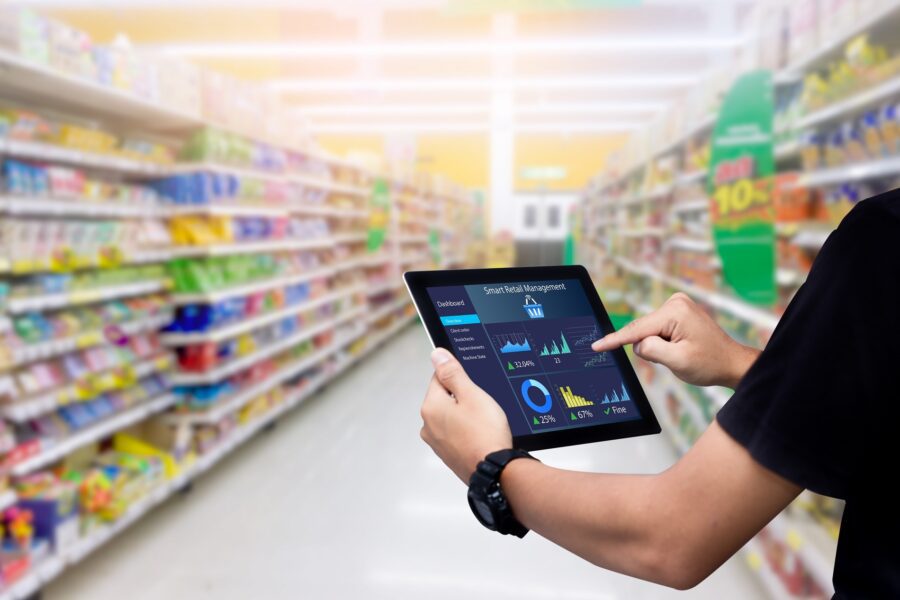
Our Blog
Retail Data Analytics: Turning Data into Decisions
Written by: Parcel Pending
5 Min Read
Published: December 8, 2023
Updated: May 24, 2024
Updated: 05/22/2024
With retailers navigating the turbulent post-pandemic waters, mediating inventory issues, and stabilizing their supply chain, they are now looking for solid and profitable solutions to ensure their continued success in the ever-competitive retail market. Enter retail data analytics – replacing all the hunches, guesswork, and intuition with high-powered data analysis to help retailers make more accurate decisions about a variety of operational functions.
Retail Analytics Defined
As leading retail analytics provider Oracle aptly explains: “Retail analytics involves using software to collect and analyze data from physical, online, and catalog outlets to provide retailers with insights into customer behavior and shopping trends.”1 Third-party data can also assist with advanced analytics and decision-making, including tracking weather trends that trigger specific purchases. PepsiCo, for example, the parent company of both Quaker® Oatmeal and Gatorade®, relies on weather forecasts to manage its supply chain and ensure adequate supply of oatmeal in the winter and its sports drink during the hot weather months.
However, there’s a burgeoning need within the retail industry for more data analysts. A recent Harvard Business Study highlighted the chasm between the elite retailers employing sophisticated business intelligence tools and data analytics and the “laggards” using data based more on historical data than predictive analytics.2 The gap is because the predictive analytics function is run byexperts who don’t “speak retail.” Now, retailers are looking for big data analytics and advanced analytics employees with both data science expertise and an understanding of the retail ecosystem.
The Benefits of Retail Analytics
Retail analytics aims to help the retail industry increase sales, reduce costs, and improve customer satisfaction and loyalty. Specifically, the customer data and other information collected affords retailers the ability to:
Personalize Marketing Messages
According to recent research, 63% of respondents state that they are more likely to shop with brands that customize, personalize, and improve the in-store shopping experience for shoppers.3 Retailers are sitting on massive amounts of customer data, including behavior data based on customer sales history and loyalty programs. Internet browsing data further affords e-tailers insight into those who visited their website but did not make a purchase. Special incentives, product recommendations, and review requests are all powered by customer analytics and data science.
Improve Inventory Management
The kiss of death in retailing is the missed sale due to out-of-stock inventory. However, there’s a delicate balance between having enough inventory and too much inventory. Big data analytics assist retailers with stocking the optimal level of product to avoid unprofitable discounting.
Create A Better Customer Experience
The concept of waiting in a retail register line is almost over, as many big box stores are equipping their sales associates with mobile devices that can quickly ring up a sale, check inventory, and identify a product’s location. These mobile devices are often integrated into retailers’ Point-of-Sale (PoS) and Order Management Systems (OMS), further tracking customer loyalty, customer satisfaction, and stores’ inventory levels.
Optimize Pricing Decisions
Dynamic pricing is finally entering the retail arena. The State of Fashion report found that 72% of fashion executives plan to increase prices in 2023.4 Given inflation and consumers’ quickly changing preferences, dynamic pricing allows for rapid-fire pricing changes while maximizing revenue. Competitive pricing of abandoned shopping carts and the cost of goods sold also determine the optimal price.
Essential Retail Analytics Tools
Below are the essential tools for deploying analytics:
Point of Sale Systems
POS systems detail not only what was purchased but also the price, the day of the week, and the time of purchase, adding insight into what items sell and when. Retail analytics software can help retailers deploy specific strategies based on the knowledge and customer analytics collected by POS systems.
Customer Relationship Management Software
Sophisticated CRM software manages many customer journey elements. CRM tools streamline the customer engagement process, close more sales deals, establish strong customer relationships, build customer loyalty, and ultimately increase sales and profits.
Inventory Management Systems
Inventory management shot to the top of retailers’ technology wish list as unsold goods in 2022 jumped 12% compared to the previous year, according to McKinsey & Company.5 Good systems today track inventory in stock as well as in warehouses and distribution centers. Of course, inventory management systems and retail analytics software also assist with forecasting.
Order Fulfillment Solutions
The order fulfillment process is defined as receiving, processing, and delivering orders to the end customer. Many e-tailers outsource the picking, packing, and processing of the purchases. However, delivery and returns processing is often subpar, leading to a poor customer experience.
By contrast, leveraging order fulfillment solutions can have a positive impact on a retailer’s fulfillment experience. For instance, Parcel Pending by Quadient smart lockers maximizes operational efficiency and profitability while boosting the customer experience. Operating costs can plummet by up to 50% by centralizing deliveries and optimizing the returns process to convenient, secure parcel locker locations. And 15% of shoppers made an additional purchase when completing an in-store return for online products. With customer impatience growing, it’s worth noting that package retrieval and returns with electronic lockers take less than 30 seconds and require no employee assistance. Of course, most parcel lockers allow for 24/7 on-demand access for pick-ups and returns.
Most importantly, when it comes to data analytics, retail parcel lockers seamlessly integrate with point of sale (POS), order management systems (OMS), and inventory management software to ensure complete visibility into where the product is – for both order collection and returns. KPIs are also easily accessed with a customizable dashboard. This business intelligence dashboard includes alerts for monitoring each system using user and data device management tools and tracking as well as notification management features.
Data analytics is the future of retail. To discover how retail parcel lockers can help you make data-driven decisions about your business operations, speak to one of our package management experts today!
Sources:
-
- Hickins, Michael. What is Retail Analytics? The Ultimate Guide. www.oracle.com. March 17, 2023. https://www.oracle.com/retail/what-is-retail-analytics/
- DeHoratius, N., Musalem, A., & Rooderkerk, R. Why Retailers Fail to Adopt Advanced Data Analytics. hbr.org. February 27, 2023. https://hbr.org/2023/02/why-retailers-fail-to-adopt-advanced-data-analytics
- Optimizely. Optimizely Survey: Consumers Report Heightened Expectations for Digital Experiences this Holiday Season. www.optimizely.com. October 14, 2021. https://www.optimizely.com/company/press/heightened-expectations-for-digital-experiences-this-holiday-season/
- Business of Fashion. Why Analytics and Agility Are Critical to Success in Today’s Retail Market. www.businessoffashion.com. August 15, 2023. https://www.businessoffashion.com/articles/retail/why-analytics-and-agility-are-critical-to-retail-success-skypad-saks-robert-graham-interview/
- Baum, C., Hauer, M., et al. Thinking beyond markdowns to tackle retail’s inventory glut. www.mckinsey.com. May 8, 2023. https://www.mckinsey.com/industries/retail/our-insights/thinking-beyond-markdowns-to-tackle-retails-inventory-glut



